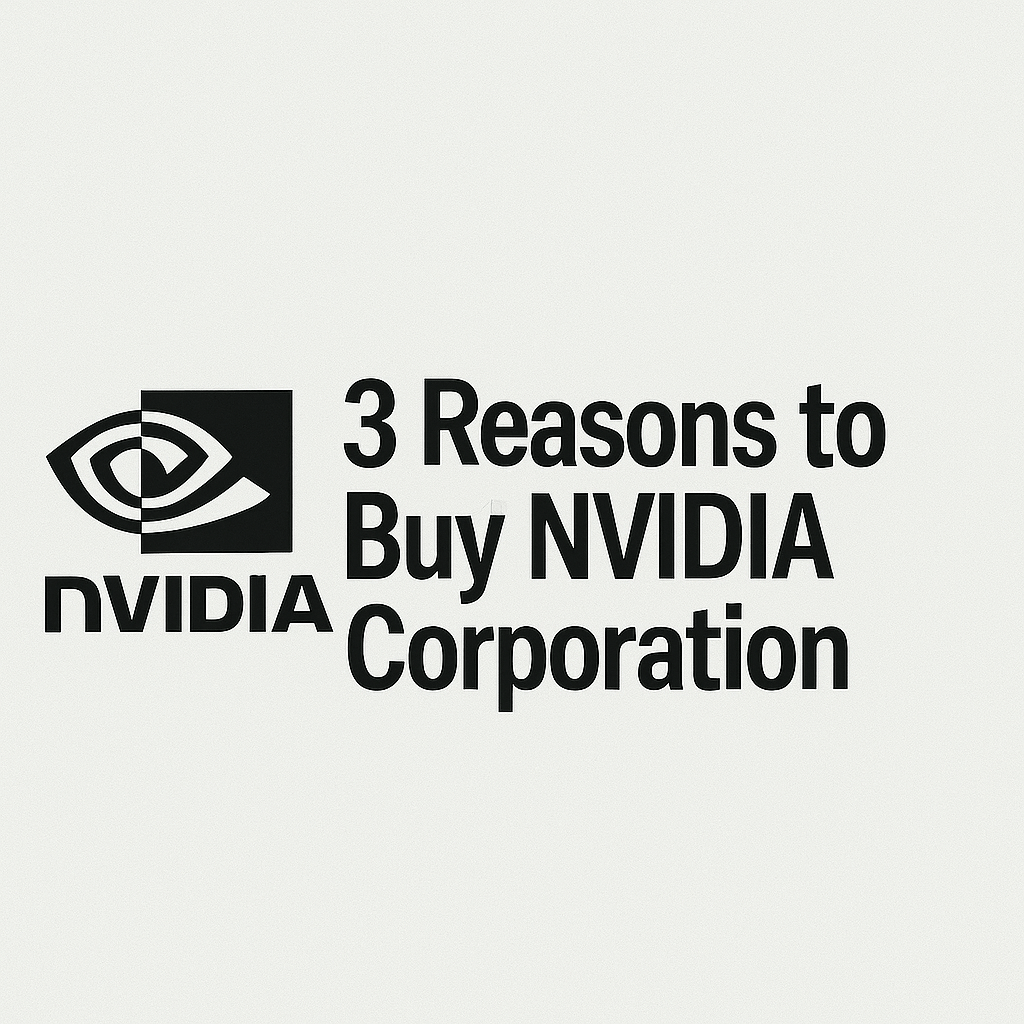Your cart is currently empty!
3 Reasons to Buy NVIDIA Corporation

NVIDIA Corporation has evolved from a niche graphics processor designer into a powerhouse at the forefront of artificial intelligence, gaming, and data centres. Investors worldwide—from the US to the UK, Italy, and broader Europe—recognise the company’s breakthrough innovations and robust financial trajectory. This article, 3 Reasons to Buy NVIDIA Corporation, explores why adding NVIDIA shares to your portfolio today could deliver substantial returns tomorrow. Throughout this analysis, you will encounter clear explanations, transition words that guide your reading, and active voice that drives key insights home.
Why 3 Reasons to Buy NVIDIA Corporation Should Convince You
Investors often search for concise, actionable rationales when evaluating potential stock purchases. By focusing on 3 Reasons to Buy NVIDIA Corporation, you gain a structured approach that highlights market leadership, growth opportunities, and financial strength. This focus keyphrase appears here to anchor your intent and align with SEO best practices. Each subsequent section delves into one of the three core rationales, providing data-driven context and global perspectives. Consequently, you can make an informed decision that matches your risk tolerance and investment horizon.
Reason One: Market Leadership in GPUs and AI Accelerators
NVIDIA’s initial success stemmed from its dominance in graphics processing units (GPUs) for gaming. These GPUs offered superior performance, enabling lifelike visuals and immersive gameplay experiences. Today, NVIDIA extends that prowess into the AI sector, where its GPUs power deep learning models, autonomous vehicles, and scientific research. By consistently releasing next-generation architectures, the company maintains a significant competitive edge over peers.
Furthermore, enterprise clients such as hyperscale cloud providers rely on NVIDIA’s solutions to accelerate data-intensive workloads. This reliance underscores the durability of demand. When assessing long-term prospects, the ability to retain and grow enterprise partnerships matters as much as consumer adoption. Consequently, NVIDIA’s network effect solidifies its market position and supports continued pricing power.
Across regions, the appetite for AI-driven insights continues to accelerate. In the United States, major technology firms integrate NVIDIA accelerators into their AI infrastructure. In Europe, research institutions leverage these GPUs for advancements in healthcare diagnostics and climate modeling. Meanwhile, in Italy and beyond, startups adopt NVIDIA’s Jetson platforms to prototype robotics and edge-AI solutions. As a result, geographic diversification amplifies revenue streams and mitigates regional slowdowns.
Reason Two: Expanding Data Center and AI Ecosystem
NVIDIA’s data centre business now represents the fastest growing revenue segment. Fueled by demand for AI training and inference, this segment outpaces traditional GPU sales. The company’s early investment in software frameworks—such as CUDA and cuDNN—creates a strong ecosystem that attracts developers and research teams. Because these software libraries accelerate adoption, they erect high switching costs for competitors attempting to lure clients away.
Moreover, NVIDIA’s AI Enterprise software suite integrates with major virtualization platforms and public clouds. This integration ensures that corporate IT departments can deploy AI services without extensive retraining. Transitioning from proof-of-concept to production environments often proves challenging, yet NVIDIA’s end-to-end solutions smooth that path. Consequently, enterprises spend on both hardware and software subscriptions, boosting recurring revenue and improving margin visibility.
On a global scale, cloud service providers in the UK and Europe are rapidly scaling AI workloads. Governments and corporations invest in AI strategies to remain competitive. NVIDIA’s partnerships with leading cloud platforms position the company to capture a significant share of this growth. From Frankfurt data centres to London’s financial district, AI adoption accelerates, and NVIDIA stands at the centre of that evolution.
Reason Three: Robust Financial Performance and Growth Prospects
NVIDIA’s financial metrics demonstrate both high growth and improving profitability. The company consistently reports double-digit revenue increases quarter over quarter. Moreover, as data centre sales contribute an ever-larger share of total revenue, gross margins expand due to higher average selling prices and software licensing revenue. This margin expansion fuels operating leverage, thereby translating revenue growth into substantial net income gains.
Investors also appreciate NVIDIA’s disciplined capital allocation. The firm reinvests heavily in research and development to sustain innovation. At the same time, prudent share repurchase programs return surplus cash to shareholders, supporting earnings per share growth. High free cash flow generation enables flexible investment in partnerships, acquisitions, and infrastructure, ensuring that NVIDIA remains atop the AI value chain.
Analysts in the US and Europe have upgraded earnings forecasts to account for AI acceleration. This consensus revision acts as a positive catalyst, often driving share price appreciation. While valuation multiples expanded in anticipation of growth, future earnings upgrades could temper such premiums, offering additional upside. Consequently, financial momentum complements technological leadership to reinforce the investment case.
Global Investor Considerations
When investing in NVIDIA across different regions, currency fluctuations and regulatory nuances matter. US investors trade on NASDAQ under the ticker NVDA, benefiting from high liquidity and immediate settlement. UK and European investors may access ADRs or local derivatives, considering FX risks between the dollar and euro or pound. Despite these considerations, the core fundamentals—market leadership, AI ecosystem, and financial strength—remain unchanged.
Regulatory developments also influence AI companies. In Europe, upcoming AI Act provisions could impose transparency requirements. However, NVIDIA’s proactive compliance efforts and collaborative industry partnerships position it favourably. In Italy and across the EU, academic and governmental research initiatives align with NVIDIA’s strategy, further cementing the company’s relevance. As a result, prudent investors monitor policy trends while maintaining conviction in NVIDIA’s secular growth drivers.
Valuation Versus Peers
Comparing NVIDIA’s valuation to peers reveals relative premiums that reflect growth expectations. Metrics such as Price-to-Sales and EV/EBITDA appear elevated compared to legacy semiconductor firms. Yet, when juxtaposed with pure-play AI and cloud infrastructure providers, NVIDIA’s multiples align with forward-looking growth trajectories. Investors must weigh these premiums against potential earnings acceleration as AI workloads proliferate.
Historical analysis shows that NVIDIA has repeatedly justified premium valuations through outperformance. For example, during the crypto mining boom, GPU sales surged unexpectedly. Similarly, AI adoption reached critical mass, catching many analysts off-guard. By emphasizing forward guidance and long-term margin targets, NVIDIA continues to set ambitious yet achievable objectives. Consequently, valuation debates often resolve as new product cycles and ecosystem expansions materialise.
Integrating Insights from Other Analyses
For further research on market-leading equities, consider how similar investment frameworks apply. Our in-depth reviews on retail and technology giants illustrate common themes. For example, 3 Reasons to Buy Walmart Stockanalyses consumer resilience and supply chain efficiencies. Likewise, 3 Reasons to Buy Apple Stock Now explores ecosystem lock-in and services revenue growth. Other sector studies—such as 3 Reasons to Buy Meta and 3 Reasons to Buy Microsoft—highlight network effects and cloud expansion. Technology investors may also review 3 Reasons to Buy Amazon and 3 Reasons to Buy Google Stock to compare AI strategies. Finally, 3 Reasons to Buy Berkshire Hathaway presents a conglomerate’s diversified approach. By synthesising these analyses, you gain a holistic view of blue-chip investing across sectors.
Risk and Mitigation Strategies
Every investment carries inherent risks. NVIDIA faces competition from new entrants in AI accelerators, potential supply chain disruptions, and fluctuating demand cycles. Geopolitical tensions may affect export controls, particularly for advanced AI chips. To mitigate these risks, investors should consider diversifying across semiconductor and AI ecosystems. Balancing NVIDIA exposure with companies such as AMD or cloud providers can reduce single-stock volatility. Moreover, maintaining a long-term horizon allows you to ride out short-term market fluctuations.
Transitioning from risk assessment to portfolio construction, prudent investors allocate position sizes based on conviction levels and overall diversification targets. In practice, NVIDIA might form a core holding in a technology-focused sleeve, while broader exposure resides in ETFs or multi-sector funds. This balanced approach captures NVIDIA’s growth potential while managing idiosyncratic risks.
Conclusion
The case for 3 Reasons to Buy NVIDIA Corporation rests on its market leadership in GPUs and AI, expanding data centre ecosystem, and robust financial performance. Investors across the US, UK, Italy, and Europe can harness these insights to position their portfolios for the AI revolution. By integrating analyses of comparable stocks—ranging from Walmart to Berkshire Hathaway—you build a diversified, growth-oriented investment strategy. Ultimately, NVIDIA’s proven innovation and strong execution underpin a compelling long-term opportunity.

Mr. Rajeev Prakash
Rajeev is a well-known astrologer based in central India who has a deep understanding of both personal and mundane astrology. His team has been closely monitoring the movements of various global financial markets, including equities, precious metals, currency pairs, yields, and treasury bonds.
